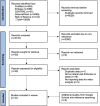Association between sinus septa and lateral wall thickness with risk of perforation during maxillary sinus lift surgery: A systematic review and meta-analysis
- PMID: 39116075
- PMCID: PMC11309397
- DOI: 10.1371/journal.pone.0308166
Association between sinus septa and lateral wall thickness with risk of perforation during maxillary sinus lift surgery: A systematic review and meta-analysis
Abstract
Objective: Sinus membrane perforation is a common complication of sinus lift surgery. This review aimed to examine if anatomical factors such as the presence of septa and lateral wall thickness influence the risk of membrane perforation.
Methods: This study was registered on PROSPERO (CRD42023488259). PubMed, Embase, and Web of Science were searched for relevant studies published up to 26th June 2024. The outcome of interest was the risk of perforation based on presence of septa and lateral wall thickness. Random-effects meta-analysis was conducted with dichotomous data to obtain the odds ratio (OR) of perforation using Review Manager.
Results: Ten studies with 1865 patients undergoing 2168 "lateral" sinus lift procedures were included. The total incidence of Schneiderian membrane perforations was 19% (405 cases). Schneiderian membrane perforation was present in 169/425 cases (39.76%) with sinus septa and 184/1492 cases (12.33%) without septa. Meta-analysis showed that septa were significantly associated with an increased risk of perforation (OR: 4.03 95% CI: 1.77, 9.19) with high heterogeneity (I2 = 87%). The certainty of the evidence was very low. Data on lateral wall thickness and risk of perforation was too heterogeneous for a meta-analysis. Studies reported mixed results on the risk of perforation based on lateral wall thickness.
Conclusions: Our results show, with very low-quality evidence, that the presence of septa significantly increases the risk of perforations during maxillary sinus lift surgery. Evidence on the association between lateral wall thickness and a risk of perforations during sinus lift surgery is conflicting, and no clear conclusions can be derived at this stage.
Copyright: © 2024 Yang et al. This is an open access article distributed under the terms of the Creative Commons Attribution License, which permits unrestricted use, distribution, and reproduction in any medium, provided the original author and source are credited.
Conflict of interest statement
The authors have declared that no competing interests exist.
Figures
Similar articles
-
Incidence, Risk Factors, and Complications of Schneiderian Membrane Perforation in Sinus Lift Surgery: A Meta-Analysis.Implant Dent. 2016 Jun;25(3):409-15. doi: 10.1097/ID.0000000000000411. Implant Dent. 2016. PMID: 26974034
-
Does intraoperative perforation of Schneiderian membrane during sinus lift surgery causes an increased the risk of implants failure?: A systematic review and meta regression analysis.Clin Implant Dent Relat Res. 2018 Oct;20(5):882-889. doi: 10.1111/cid.12660. Epub 2018 Aug 31. Clin Implant Dent Relat Res. 2018. PMID: 30168884
-
Which factors affect the risk of membrane perforation in lateral window maxillary sinus elevation? A prospective cohort study.J Craniomaxillofac Surg. 2023 Jul-Aug;51(7-8):427-432. doi: 10.1016/j.jcms.2023.06.010. Epub 2023 Jun 28. J Craniomaxillofac Surg. 2023. PMID: 37423790
-
The influence of sinus membrane thickness upon membrane perforation during lateral window sinus augmentation.Clin Oral Implants Res. 2016 May;27(5):612-7. doi: 10.1111/clr.12646. Epub 2015 Jun 16. Clin Oral Implants Res. 2016. PMID: 26076580
-
Does sinus membrane thickness influence the risk of perforation during lateral sinus lift surgery for dental implants? a systematic review and meta-analysis.Med Oral Patol Oral Cir Bucal. 2024 Jul 1;29(4):e568-e574. doi: 10.4317/medoral.26545. Med Oral Patol Oral Cir Bucal. 2024. PMID: 38794940 Free PMC article.
Cited by
-
Prevalence of maxillary sinus septa and its impact on sinus augmentation procedures for implant placement.Bioinformation. 2025 May 31;21(5):1123-1127. doi: 10.6026/973206300211123. eCollection 2025. Bioinformation. 2025. PMID: 40822786 Free PMC article.
References
-
- Lozano-Carrascal N, Anglada-Bosqued A, Salomó-Coll O, Hernández-Alfaro F, Wang HL, Gargallo-Albiol J. Short implants (<8mm) versus longer implants (≥8mm) with lateral sinus floor augmentation in posterior atrophic maxilla: A meta-analysis of RCT`s in humans. Med Oral Patol Oral y Cir Bucal. 2020;25: e168–e179. doi: 10.4317/medoral.23248 - DOI - PMC - PubMed
-
- Romero-Millán J, Hernández-Alfaro F, Peñarrocha-Diago M, Soto-Peñaloza D, Peñarrocha-Oltra D, Peñarrocha-Diago M-A. Simultaneous and delayed direct sinus lift versus conventional implants: Retrospective study with 5-years minimum follow-up. Med Oral Patol Oral Cir Bucal. 2018;23: e752–e760. doi: 10.4317/medoral.22612 - DOI - PMC - PubMed
Publication types
MeSH terms
LinkOut - more resources
Full Text Sources




